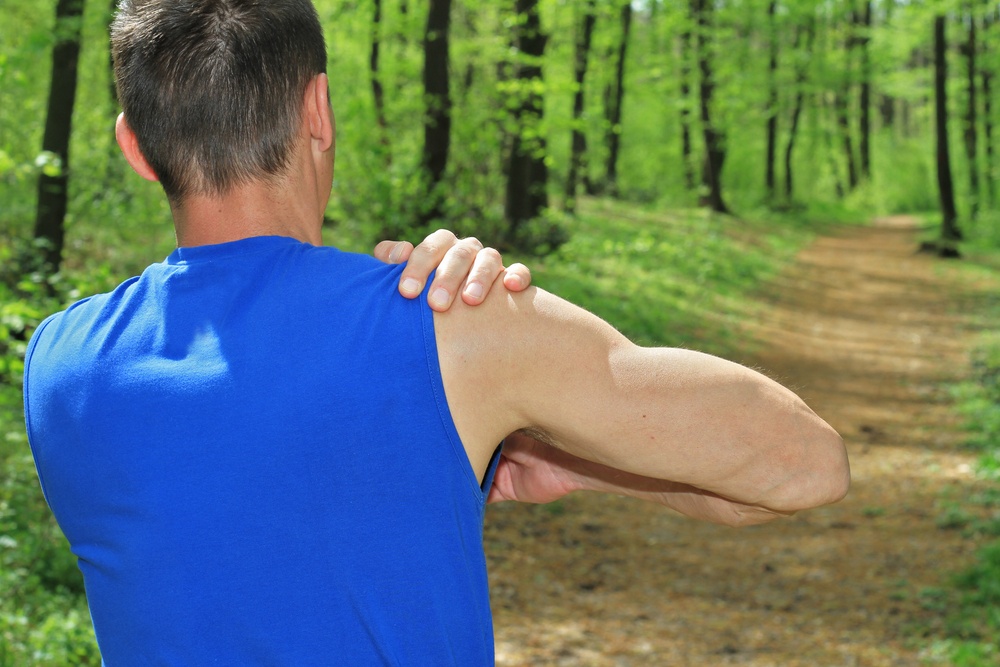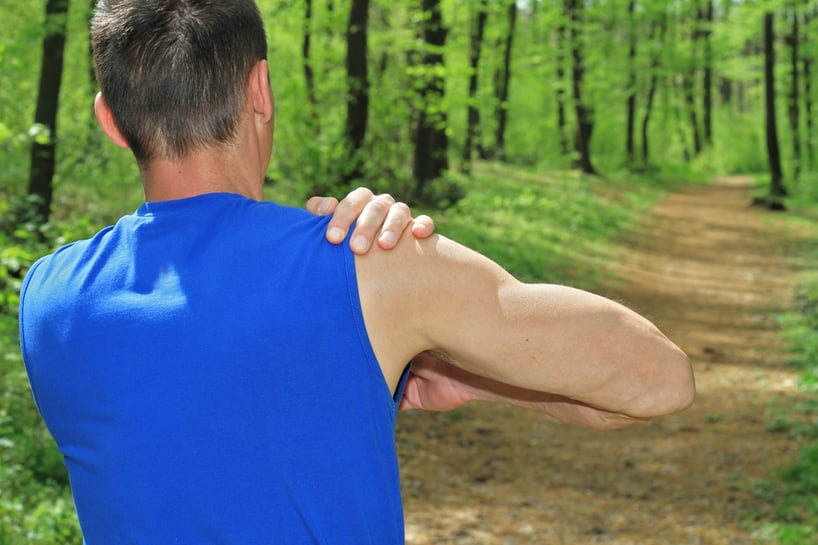Rotator Cuff Tendinopathy: Causes, Risk Factors, and Symptoms
September 5th, 2017 | 5 min. read


Rotator cuff tendinopathy (sometimes called tendinopathy of the shoulder) is, generally speaking, an overuse injury affecting the tendons of the shoulder. If you have this shoulder injury, your primary symptom is usually pain. You may also experience related issues affecting your shoulder joint, like tenderness and limitations to your normal range of motion.
What is rotator cuff tendinopathy, and how does it differ from tendonitis?
Tendinopathy is an umbrella term used to describe tendon-related injuries. You may sometimes see this term used interchangeably with “tendonitis” (sometimes spelled “tendinitis”) and “tendinosis.” Many doctors use these terms loosely to describe tendon-related pain or inflammation.
However, over time, the orthopedics field has refined these definitions to mean slightly different things:
- Tendinitis is an acute tendon injury characterized by inflammation and irritation of the tendons. It’s most often caused by what’s called an extrinsic factor—a force or factor outside the tendon itself, such as a blow, a collision, a fall, a movement (like a sudden overstretching or compression of the tendon), or friction with, or crowding from, another body part.
Rotator cuff tendinitis (a.k.a. shoulder impingement syndrome), for example, is often caused by a sudden or habitual body position or repetitive motion that presses the shoulder tendons up against the acromion bone at the top of the shoulder joint. This friction leads to micro-tears in the tendon, which leads to inflammation, soreness, and swelling. - Tendinosis is a chronic tendon injury with no inflammation, but with breakdown of the tendon tissue at the cellular level. Chronic tendon injuries often occur due to repetitive strain and overuse (for example, swinging a hammer or axe every day, or throwing a baseball). They are often caused by a combination of extrinsic factors (e.g., anatomical issues affecting the tendon, like posture, athletic form, bone spurs, muscle composition, etc.) and intrinsic ones, native to the tendon itself (e.g., genetics).
Rotator cuff tendonosis is degenerative in nature, and often the result of inherited genetics, age or repetitive strain. Over time, the tendon becomes worn and weak and can’t repair damage like it used to. This can lead to partial-thickness tears or full-thickness tears of the tendon. - Tendinopathy is any chronic tendon disease that could be caused by a number of extrinsic and intrinsic factors. Tendinopathy may be biological in nature (with changes in tissue at the cellular level) or it may be mechanical (related to how your shoulder joint is put together anatomically). It may or may not include inflammation or tears.
Rotator cuff tendinopathy is therefore a kind of “catch-all” term used to describe an ongoing disease of the shoulder tendon that could have multiple causes. The tendinopathy is chronic because the tendon is breaking down its collagen faster than it can repair itself.
Whatever is causing the problem—be it mechanics, repetitive strain, or something biological/cellular—is getting in the way of the rotator cuff tendons’ ability to heal.
LEARN MORE ABOUT ROTATOR CUFF SURGERY
Rotator Cuff Tendinopathy Causes
What are the causes of rotator cuff tendinopathy? As mentioned above, the clinical contributors to this shoulder problem are divided into two basic categories: extrinsic causes and intrinsic causes. Sometimes the tendinopathy is caused by one or the other, and sometimes it’s caused by both.
Extrinsic causes of shoulder tendinopathy can include factors such as:
- Anatomical variations. Variables in your body’s build—for example, bone shape or musculature—can lead to friction or crowding; a common cause is an irregularity in the shape of the acromion bone (at the top of your shoulder joint). A protrusion may lead to a tendon rubbing against bone over time.
- Bone spurs. The formation of excess calcium deposits—bony growths called bone spurs or osteophytes—on the bones of shoulder can similarly lead to friction and crowding, which can irritate or tear a tendon.
- Other mechanical or postural issues in the back or shoulder. In some people, for example, the scapula (shoulder blade) may be positioned irregularly when it’s in motion or when it’s at rest. This condition is called scapular dyskinesis. Often this deviation from the norm is caused by repetitive strain, which creates an imbalance that may lead the scapula to “slide off track.” (Similar to the way knees can be out of alignment, leading to knee injury.) As with so many mechanical injuries resulting from movement-related stress or strain, one single deviation creates a domino effect, leading to problems elsewhere. Instability or asymmetry in the scapula can affect the mechanical function of the entire shoulder.
Intrinsic causes of shoulder tendinopathy can include:
- As we get older, our collagen gets weaker.
- Blood supply. Anything that affects adequate blood supply to the shoulder joint and more specifically, to the tendons, may affect the tendons’ ability to self-heal from micro-tears and other trauma. Swelling or microvascular disease, for example, may inhibit blood flow to the shoulder.
- Gradual breakdown at the cellular level erodes the collagen in the tendon, speeding breakdown and inhibiting self-repair. Degeneration can have different causes, including genetics and illness.
- Repeatedly subjecting a shoulder tendon to more force than it can handle can lead to damage like micro-tears, thickened scar tissue, weakness, nerve irritation, and inflammation.
- Repetitive strain from overhand motions—throwing a baseball, serving in tennis, swimming, painting a house—can similarly lead to trauma.
Quite often, the tendinopathy will affect the supraspinatus tendon of the rotator cuff, which is attached to the supraspinatus muscle. Together they play a large role in stabilizing the shoulder.
Most people, especially athletes, who present with tendinopathy can expect overuse of the shoulder, and overloading of the rotator cuff, to be the single biggest factor affecting their injury.
Rotator Cuff Tendinopathy Symptoms
Typical symptoms of rotator cuff tendinopathy include:
- Dull or gradually increasing pain. Most noticeable when you’re lifting objects 90 degrees or higher, when you’re reaching above your head or behind your back, or when you’re sleeping on your side.
- Weakness of the shoulder that increases gradually over time (usually along with the aforementioned pain and soreness).
- Tenderness/swelling. If your tendinopathy is accompanied by inflammation, you may notice swelling or redness over the shoulder area.
- Stiffness and reduced function and mobility—also getting gradually worse.
Because many shoulder issues share similar symptoms (among them, muscle weakness, fractures, frozen shoulder, shoulder impingement, torn rotator cuffs, and SLAP lesion tears), it’s important to see an orthopedist or physical therapist for proper testing and diagnosis.
Rotator Cuff Tendinopathy Risk Factors
Are you at risk for rotator cuff tendinopathy? You may be if you match some of the following criteria.
- Athletes who regularly practice or participate in an overhand throwing or serving sport are at risk: e.g., those who play baseball, football, softball, squash, tennis, track and field (javelin, shot put), and volleyball. Baseball pitchers are particularly vulnerable to rotator cuff injuries due to the repeated overhand motion of pitching, combined with the rotation of the shoulder. Load-bearing activities that cause you to lift heavy weights above shoulder level can also create trauma to the rotator cuff tendons (think competitive cheerleading, figure skating, and some forms of dance like ballet—if you lift another human above your head, you’re hoisting a heavy load.)
- Workers who raise their arms above shoulder level are at increased risk. House painters (interior and exterior), construction workers, and certain kind of factory workers frequently sustain shoulder injuries. If your work is load-bearing in any way, you’re at even greater risk—for example, if you’re lifting something heavy over your head, repeatedly. (For example, kitchen workers who regularly retrieve and put away large appliances on high shelves.)
- If you’re over 40 (man or woman), the general wear and tear of getting older can make you more susceptible to shoulder injuries. Post-menopausal women are particularly susceptible to tendon issues, possibly related to a deficiency of estrogen.
- Studies indicate that being overweight, obese, or having a higher-than-average BMI can put you at greater risk for tendinopathy, especially if you’re a man.
- Diabetes and other metabolic disorders. Experts believe that poor glycemic control can lead to buildups of advanced glycation end-products (AGEs) in the bloodstream. These can contribute to inflammation and may ultimately weaken tendons.
The bottom line: if you have chronic, gradually increasing shoulder pain or limited shoulder movement, don’t put off a visit to the doctor. Ignoring your pain and continuing to use your shoulder could be contributing to a chronic condition that may require treatment or surgery.
Contact Coastal Orthopedics in Corpus Christi, Texas today at (361) 994-1166 to schedule an appointment today for any shoulder issues. Our staff is ready to answer your questions and get you feeling better!
Article written by: Rob Williams, MD
Dr. Williams has been practicing orthopedic surgery in Corpus Christi since 1998. After graduating from Texas Tech hereceived his medical degree from the University of Texas at San Antonio. At the prestigious Campbell Clinic located at the University of Tennessee, Dr. Williams completed not only an Orthopedic Surgery Residency, but an additional year of Fellowship Training in Spine Surgery. Dr. Williams is dedicated to creating an excellent patient experience in the office or in the surgery suite.
Topics:


